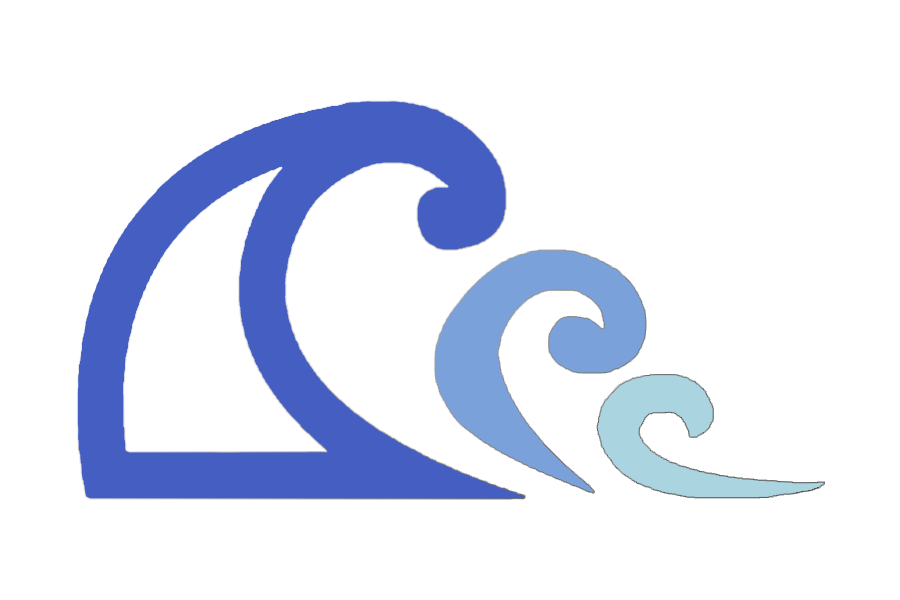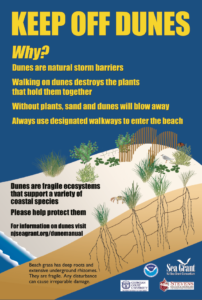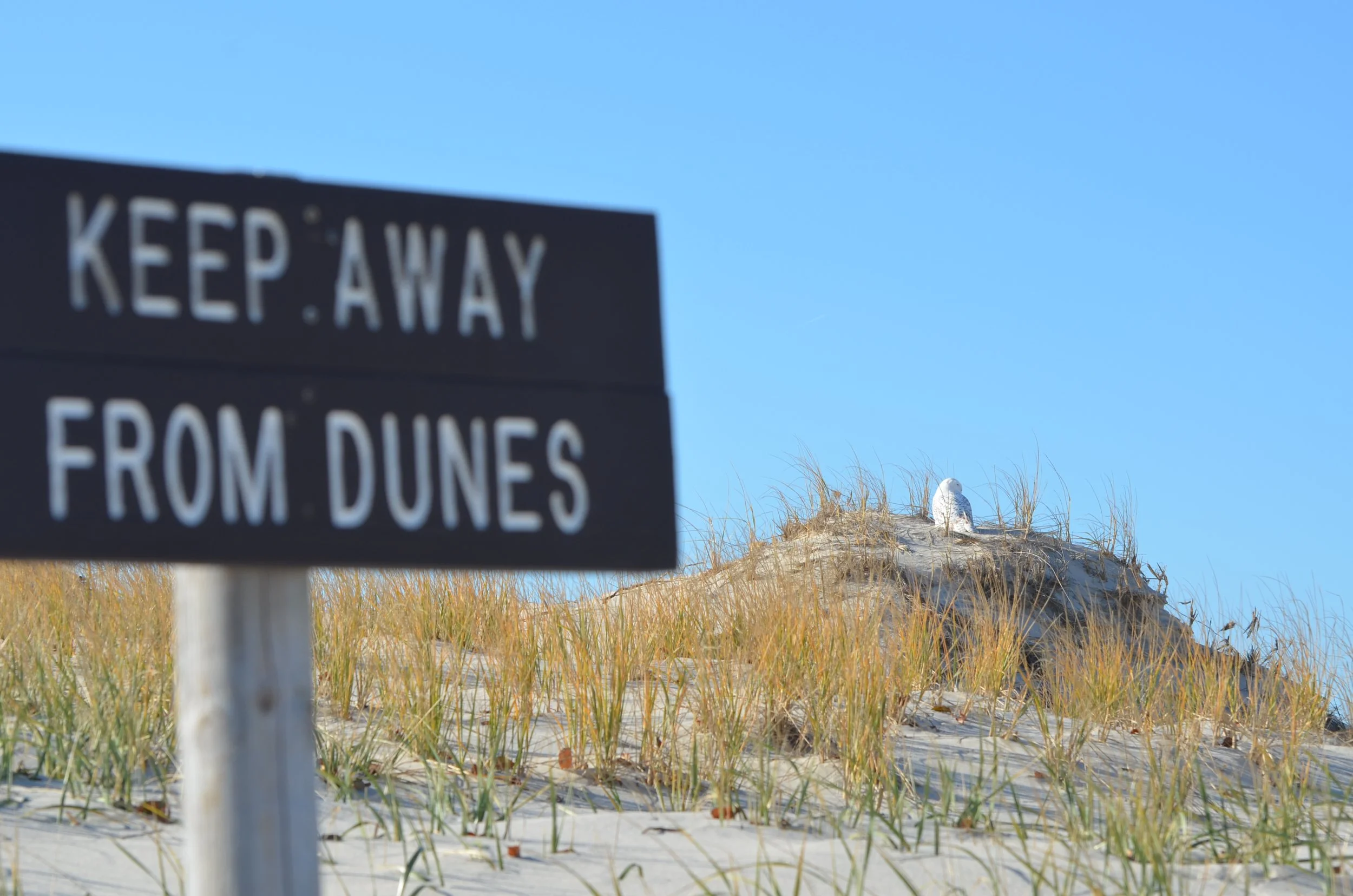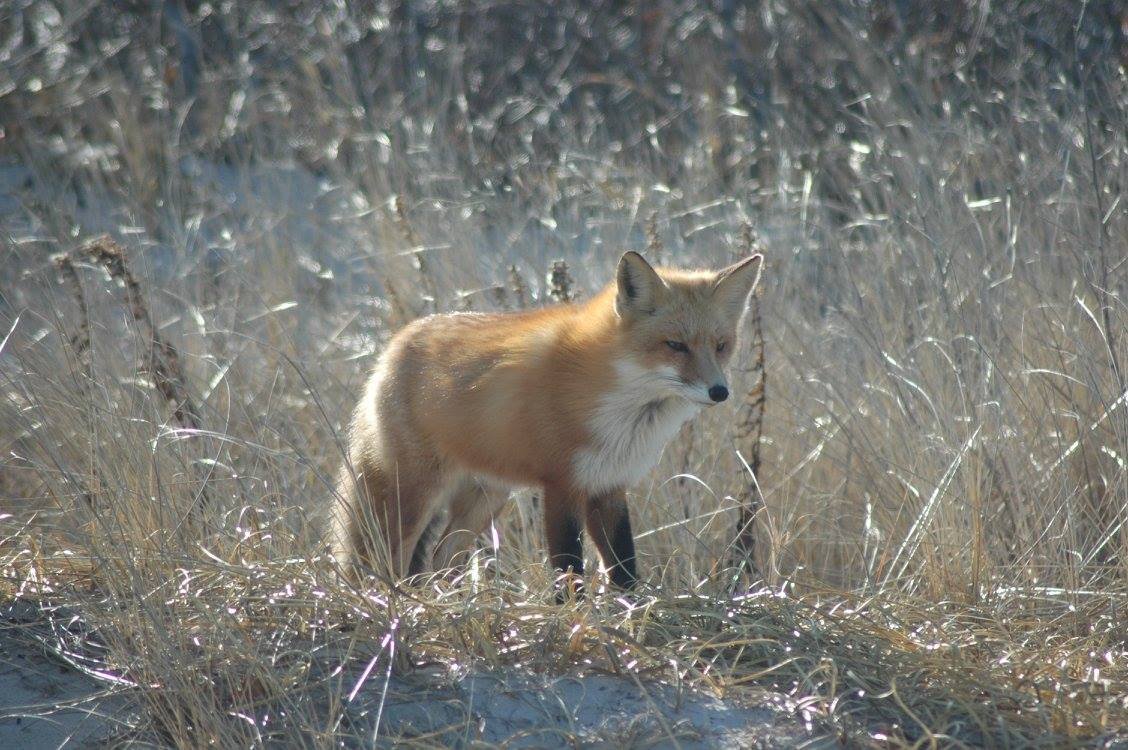
Natural Resource Protection and Safety
What’s here to protect
Island Beach State Park is one of the few remaining undeveloped barrier Islands on the East Coast that has been left as a natural as possible. Throughout the year our park can receive a million visitors, some come for the pristine beach while others for the unique opportunities to bird watch, fish crab or clam recreationally and enjoy water sports. In order to protect the visitor and the environment we have tips, enforced rules and regulations about recreating within the park and with wildlife. This feat of conservation is managed with the help of our partners to ensure this treasure is passed on to future generations.
Keep off Dunes
Throughout the Island before and after the beach accesses there are informational signs(image to the right) that will give you a brief reason why you should not walk on the dunes. There are also fines up to $1,500 for trespassing onto the dunes. For more information about why we are so strict about keeping off the dunes continue reading.
Dunes are a fragile ecosystem
Dune life begins on the upper beach(the east-most section) which flows into the primary dune and continues into the secondary dunes(west-most section). While only a small percentage of the dunes are made up of vegetation they are entirely responsible for the stabilization of the dunes. This is due to the adaptations of the american beachgrass(Ammophila breviligulata) that helps traps the sand that is blown by the wind while continuing grow above ground and send its long stabilizing roots below. These amazing plants, when established and undisturbed will send out rhizomes to create “new” plants or clones; if stepped on the rhizomes can break and catch a fungal infection that can lead to the plants death. Too much plant death will directly impact the stability of the dune which can lead to blowouts during strong storms.
The dune ecosystem is also the only home for other federally threatened plants like the seabeach amaranth(Amaranthus pumilus). Due to the ever changing coast line and human impact seabeach amaranth was once considered lost from New Jersey, this species has made an incredible comeback. New Jersey’s DEP Bureau of GIS and the Office of Natural Lands Management created a storymap about its history in New Jersey. Other federally and state threatened plants are the seaside knotweed(Polygonum glaucum) and the seabeach sandwort(Honckenya peploides).
Animal life up on the dunes is more limited where drying winds blow sand and small creatures alike. Crabs sometimes forage here as do insects but mostly the dunes are for birds. Notable insects include the Northeastern Tiger Beetle(Cicindela dorsalis dorsalis) a federally threatened species that lays its eggs on the dunes. In addition colonies of ground-nesting birds scrape shallow nests in the sand between the high tide line and the top of the dunes. The adult birds fly then into the nearby estuary and ocean to feed and bring back food to their young. The piping plover(Charadrius melodus) and the red knot(Calidris canutus rufa), two federally threatened birds, in addtion to others like the least tern(Sternula antillarum), black skimmer(Rynchops niger), and the american oytercatcher(Haematopus palliatus) also use the dune ecosystem to fuel migrations or rear young. In the winter the snowy owl(Bubo scandiacus) will use the dunes to rest before migrating back to the Artic.
Dunes are natural storm barriers
The primary dune ecosystem has been crafted through time to be able to withstand the forces of hurricanes to nor’easter’s. Many of the dunes that are still standing withstood hurricane sandy but at times even they fall to the forces created during storms. As mentioned above the stability of the dunes comes from the american beach grass roots reaching deep into the dunes and when stepped on can leave gaps due to plant dieback. Any large gaps in vegetation can create the beginnings of a blowout that can be exasperated by large storms. So let’s give our dunes a fighting chance and agree to stay off of them!
Visit New Jersey Sea Grant Consortium (NJSGC) or Protect NJ Dunes for more on Dunes and the efforts made in establishing and protecting them or stop by the Nature Center and grab Protecting Our Shoreline informational pamphlet.
No Swimming(without a lifeguard)
Some of the many shipwrecks off the coast.
Swimming at Island Beach State Park is only permitted when lifeguards are on duty and only in the designated swimming areas. All other trail accesses specifically state NO SWIMMING.
Did you know that the Jersey Coast earned the nickname “the Graveyard of the Atlantic.” And it got to the point where life saving stations were constructed in response to the coast’s ever changing shoals that resulted in 200 ships being wrecked during the winter of 1826-27. With such an unpredictable and strong force of nature we ask that you only swim in the designated areas. Rip currents pose a threat even to the most experienced swimmers, below are the recommendations of the National Oceanic and Atmospheric Administration and the United States Lifesaving Association.
Wildlife
We ask park visitors not to feed or disturb the wildlife so that both parties stay as safe as possible and enjoy their time; from the Osprey in their stands, the Snow Owl in the dunes or the seal resting on the beach. Please remember to keep your distance no matter the animal.
Please continue reading to see further explanations of how disturbing the wildlife can harm their populations.
Red Fox(Vulpes vulpes)
Island Beach is home to a small, but stable population of Red Fox. Most visitors are familiar with these "beautiful beggars”, who regularly appear alongside of and in the road in hopes of obtaining food. Despite posted signs, many visitors cannot resist feeding the red foxes which are often on the road, in the mistaken belief that they are helping them. This has caused the fox to become accustomed, or used to people. This change in behavior is dangerous for the foxes and the public for a number of reasons:
Fox fed along the road run an increased risk of being hit by a car. At Island Beach, vehicular traffic takes the place of hunting and trapping. A number of our fox are killed by cars every year as they are lured into the road by people feeding them. Do not feed them! In addition, please adjust your speed when wildlife is near the road edge.
Ingesting other than what nature provides increases the animals risk of contracting disease or suffering from malnutrition. Even in winter, there is sufficient food in the wild.
Hand feeding increases the possibility of people being bitten or scratched by animals that are not domesticated, no matter how “friendly” they may appear.
Feeding any wild animal discourages natural behaviors such as hunting. In fact, some kids are being taught to panhandle rather than hunt by their parents.
Feeding or disturbing wildlife is unlawful. Violators will be issued summonses by ranger personnel.
This appeal was written in response to an increase in fox fatalities at Island Beach State Park as they venture into the road in search of human handouts. We urgently need your help to ensure that future generations of park visitors can enjoy these lovely animals. If you are lucky enough to catch a glimpse of a red fox, please remember that it is a wild animal, and as such should be enjoyed and respected from a distance. Thank you.
Snow Owl
During the winter months we are visited by the snowy owl(Bubo scandiacus), who makes an arduous journey from the artic to “nest” on our dunes before making the journey back. Due to the rarity and beauty of this owl it’s presence can attract photographers and birders from all over. Often times these owls are naïve to the danger of human impacts so we ask watchers to not crowed or disturb the owls.
Please click below to learn about how to be a good observer if you are able to spot a Snow Owl.
Snowy Owl Etiquette by Project Snow Storm
Stranded Marine Animal
The East Coast is an important migration route for many marine mammals. Migration takes an tremendous amount of effort for these animals and frequently they will stop to rest on land rather and are not stranded. If you believe that a marine animal is stranded on our beaches and is in distress please report it to The Marine Mammal Stranding Center (MMSC) by calling there 24 hour hotline at (609) 266-0538.
Remember to observe these animals from a distance as they can be dangerous if they feel threatened.
Pests
Island Beach State Park being an undeveloped barrier Island means that there are going to be more pests than you would expect at the beach. There are three insects that become a nuisance during the warmer months; ticks, mosquitos and biting flies. Another nuisance that has an important function within our parks is poison ivy. Since we are unable to remove these pests, nor should we be able to, we have to adapt to the best of our abilities. Below you can find guidance on best practices to ensure your safety while visiting.
Ticks
A full description of what ticks can be found in New Jersey can be found here. Anytime you have to traverse the vegetated areas of the park please come prepared with long pants that are tucked into long socks or remember to do a thorough tick check when possible. There are also chemical repellants, like permethrin, that can be sprayed onto clothing that have been shown to be effective against tick Ticks are known to harbor infectious pathogens that can lead to debilitating diseases. Areas that are prone to higher populations of ticks are the Reed Road and Spizzle Creek trail.
Mosquitos
It is no surprise that mosquitos are a pest on this island. Chemical repellants offer the best protection outside of dressing in full length clothing.
Biting Flies
If you happen to be at the tail end of the wind during the warmer months you may be bothered by the biting flies that make the island their home. If the wind is blowing from the East then the flies will be carried over onto the bayside of the island and the inverse is true; if the wind is blowing from the West then the flies will be carried over to the oceanside. The only preventive measure is to know where they will be on the particular day of your visit.
Poison ivy
Leaves of three, let it be is a popular colloquialism that helps spot and avoid poison ivy. If you come in contact with poison ivy the oil that coats the leaves (urushiol) can leave a rash if you are allergic to it. If this oil is left on the first contact point it can easily be rubbed onto other parts of the body. If you find yourself in contact with poison ivy using an wash like Tecnu will neutralize the oils, the second best option is rubbing alcohol and the third will be soap and water but these are not as effective as a formulated wash.






